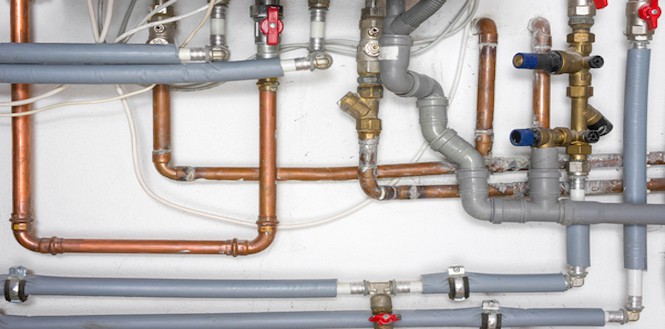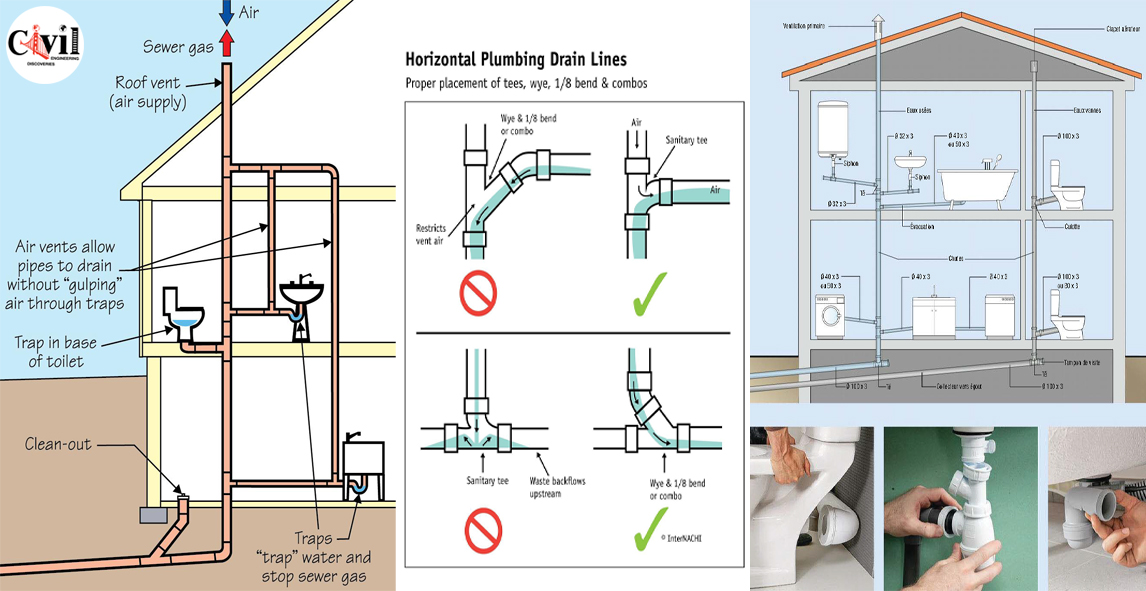Understanding Your Property's Plumbing System Anatomy
Understanding Your Property's Plumbing System Anatomy
Blog Article
We've found the article pertaining to Understanding Your Home's Plumbing Anatomy directly below on the net and think it made sense to discuss it with you on this site.

Comprehending how your home's pipes system functions is necessary for every single house owner. From providing clean water for drinking, food preparation, and bathing to securely getting rid of wastewater, a well-kept pipes system is vital for your family's wellness and comfort. In this extensive guide, we'll discover the elaborate network that makes up your home's plumbing and offer suggestions on upkeep, upgrades, and taking care of usual problems.
Introduction
Your home's pipes system is more than just a network of pipes; it's a complicated system that ensures you have accessibility to tidy water and efficient wastewater removal. Recognizing its components and exactly how they interact can help you avoid pricey repairs and make sure every little thing runs smoothly.
Basic Components of a Plumbing System
Pipes and Tubing
At the heart of your pipes system are the pipelines and tubing that bring water throughout your home. These can be made from different materials such as copper, PVC, or PEX, each with its advantages in terms of longevity and cost-effectiveness.
Fixtures: Sinks, Toilets, Showers, etc.
Fixtures like sinks, toilets, showers, and bathtubs are where water is used in your house. Comprehending exactly how these components attach to the pipes system assists in identifying problems and preparing upgrades.
Shutoffs and Shut-off Points
Shutoffs regulate the circulation of water in your plumbing system. Shut-off valves are critical throughout emergency situations or when you require to make repair work, enabling you to isolate parts of the system without interfering with water circulation to the entire home.
Water System System
Main Water Line
The primary water line links your home to the municipal water supply or an exclusive well. It's where water enters your home and is dispersed to different components.
Water Meter and Stress Regulator
The water meter procedures your water use, while a pressure regulatory authority guarantees that water streams at a secure stress throughout your home's plumbing system, protecting against damages to pipes and components.
Cold Water vs. Hot Water Lines
Comprehending the distinction between cold water lines, which provide water directly from the main, and warm water lines, which bring heated water from the hot water heater, assists in troubleshooting and preparing for upgrades.
Drain System
Drain Pipes Pipes and Traps
Drain pipelines bring wastewater away from sinks, showers, and bathrooms to the sewer or septic tank. Traps protect against sewage system gases from entering your home and likewise trap particles that could create clogs.
Air flow Pipelines
Ventilation pipelines enable air into the drain system, stopping suction that can reduce drainage and trigger catches to empty. Correct ventilation is important for keeping the honesty of your plumbing system.
Value of Proper Drain
Making certain proper drain avoids back-ups and water damage. On a regular basis cleansing drains and preserving catches can prevent costly repair work and expand the life of your pipes system.
Water Heating System
Kinds Of Hot Water Heater
Hot water heater can be tankless or conventional tank-style. Tankless heating systems heat water on demand, while storage tanks save heated water for immediate usage.
Upgrading Your Plumbing System
Reasons for Updating
Updating to water-efficient components or replacing old pipes can enhance water quality, decrease water expenses, and raise the worth of your home.
Modern Plumbing Technologies and Their Benefits
Check out innovations like clever leak detectors, water-saving toilets, and energy-efficient water heaters that can conserve cash and lower environmental influence.
Expense Factors To Consider and ROI
Compute the ahead of time costs versus long-lasting cost savings when taking into consideration plumbing upgrades. Numerous upgrades pay for themselves with lowered energy costs and fewer repair work.
Just How Water Heaters Connect to the Plumbing System
Understanding how water heaters connect to both the cold water supply and hot water distribution lines assists in identifying problems like not enough warm water or leakages.
Upkeep Tips for Water Heaters
On a regular basis purging your hot water heater to get rid of debris, examining the temperature level setups, and checking for leakages can prolong its life expectancy and enhance energy efficiency.
Common Plumbing Issues
Leaks and Their Reasons
Leakages can happen because of aging pipes, loosened installations, or high water stress. Attending to leaks quickly prevents water damages and mold and mildew growth.
Blockages and Blockages
Clogs in drains pipes and bathrooms are commonly triggered by flushing non-flushable items or a build-up of grease and hair. Using drainpipe screens and being mindful of what drops your drains pipes can prevent clogs.
Indicators of Pipes Issues to Watch For
Low tide stress, sluggish drains, foul odors, or unusually high water costs are indications of potential pipes issues that should be resolved immediately.
Plumbing Upkeep Tips
Routine Inspections and Checks
Set up annual pipes assessments to catch concerns early. Search for indicators of leakages, corrosion, or mineral accumulation in taps and showerheads.
Do It Yourself Maintenance Tasks
Straightforward tasks like cleansing faucet aerators, looking for bathroom leakages making use of color tablet computers, or shielding subjected pipelines in cool climates can stop significant plumbing issues.
When to Call a Professional Plumbing Technician
Know when a pipes issue needs specialist experience. Attempting intricate repair work without correct expertise can cause even more damage and higher fixing costs.
Tips for Lowering Water Usage
Straightforward habits like dealing with leaks promptly, taking much shorter showers, and running full tons of washing and dishes can preserve water and reduced your utility bills.
Eco-Friendly Pipes Options
Take into consideration lasting plumbing products like bamboo for floor covering, which is durable and green, or recycled glass for countertops.
Emergency situation Readiness
Actions to Take Throughout a Pipes Emergency situation
Know where your shut-off valves are located and exactly how to shut off the water supply in case of a ruptured pipeline or major leak.
Relevance of Having Emergency Situation Calls Helpful
Maintain get in touch with info for regional plumbings or emergency situation services readily offered for quick action throughout a pipes situation.
Ecological Influence and Preservation
Water-Saving Components and Devices
Mounting low-flow taps, showerheads, and commodes can dramatically lower water usage without compromising performance.
DIY Emergency Fixes (When Appropriate).
Short-term repairs like using air duct tape to spot a dripping pipe or putting a bucket under a dripping faucet can decrease damage until a professional plumbing arrives.
Conclusion.
Recognizing the makeup of your home's pipes system empowers you to keep it properly, conserving time and money on repair work. By following normal maintenance regimens and staying informed concerning modern-day pipes innovations, you can ensure your pipes system runs efficiently for years ahead.
The Anatomy of Your Home s Plumbing System
Understanding the anatomy of your home s plumbing system is essential for any homeowner. It not only helps in identifying potential issues but also facilitates effective communication with professionals when repairs or upgrades are needed. Your home s plumbing system is more than just pipes and faucets; it s a complex network that ensures the efficient and hygienic flow of water in and out of your house. In this blog, we ll dissect the crucial components of your home s plumbing system. For those in Antelope Valley, Brock Plumbing is your trusted partner for all your plumbing needs, ensuring your system functions smoothly and efficiently.
Water Supply System
Main Water Line: This is where your home s plumbing system begins. The main water line connects your home to the public water supply or a private well. Pipes and Shut-off Valves: Pipes distribute water throughout your home. Shut-off valves are crucial for controlling the flow of water and making repairs without shutting off the entire system. Drainage System
Drain Pipes: These pipes carry waste and water away from sinks, toilets, and showers. Vents: Vents allow sewer gases to escape and help maintain proper pressure in the drainage pipes, ensuring efficient flow of wastewater. Traps: Every fixture has a trap, a U-shaped pipe that holds water and prevents sewer gases from entering your home. The most common is the P-trap under sinks. Fixtures and Appliances
Fixtures and appliances are the most interacted with parts of your plumbing system. They include sinks, toilets, showers, dishwashers, and washing machines. Each fixture and appliance has its own supply and drainage connection, ensuring they receive clean water and can dispose of wastewater effectively.
Water Heating System
Your water heater is a crucial component, providing hot water to various fixtures and appliances in your home. It can be tank-based or tankless, with each type having its own set of advantages and maintenance requirements. Regular maintenance is essential to ensure efficient operation and extend the lifespan of the unit.
Sump Pump
In areas prone to flooding or with high water tables, a sump pump is an essential part of the plumbing system. It s installed in the lowest part of your basement or crawlspace and pumps out water that accumulates, preventing flooding and protecting your home from water damage.
Septic System
Homes that are not connected to a municipal sewer system have a septic system and an underground wastewater treatment structure. Understanding how to maintain your septic system is crucial to prevent backups, odors, and early system failure.
Conclusion
Your home s plumbing system is a complex and essential network, ensuring the efficient and hygienic flow of water in and out of your property. Understanding its key components helps in maintaining it properly and identifying issues before they escalate into major problems. For residents in Antelope Valley, Brock Plumbing is dedicated to providing top-notch services, ensuring that every part of your plumbing system is in perfect working order. Trust our team of professionals to handle all your plumbing needs, ensuring your home remains comfortable, safe, and well-maintained.
https://brockplumbinganddrains.com/blog/the-anatomy-of-your-homes-plumbing-system/

Do you really like reading up on Understanding Your Home's Plumbing Anatomy? Leave feedback below. We would be glad to hear your views about this blog entry. In hopes that you come back again before long. Be sure to take the opportunity to promote this article if you appreciated it. We cherish reading our article about Exploring Your Homes Plumbing Anatomy.
Book A Service Call Report this page